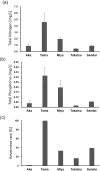Evaluation of fish biodiversity in estuaries using environmental DNA metabarcoding
- PMID: 33022692
- PMCID: PMC7538199
- DOI: 10.1371/journal.pone.0231127
Evaluation of fish biodiversity in estuaries using environmental DNA metabarcoding
Abstract
Biodiversity is an important parameter for the evaluation of the extant environmental conditions. Here, we used environmental DNA (eDNA) metabarcoding to investigate fish biodiversity in five different estuaries in Japan. Water samples for eDNA were collected from river mouths and adjacent coastal areas of two estuaries with high degrees of development (the Tama and Miya Rivers) and three estuaries with relatively low degrees of development (the Aka, Takatsu, and Sendai Rivers). A total of 182 fish species across 67 families were detected. Among them, 11 species occurred in all the rivers studied. Rare fishes including endangered species were successfully detected in rich natural rivers. Biodiversity was the highest in the Sendai River and lowest in the Tama River, reflecting the degree of human development along each river. Even though nutrient concentration was low in both the Aka and Sendai Rivers, the latter exhibited greater diversity, including many tropical or subtropical species, owing to its more southern location. Species composition detected by eDNA varied among rivers, reflecting the distribution and migration of fishes. Our results are in accordance with the ecology of each fish species and environmental conditions of each river.
Conflict of interest statement
The authors have declared that no competing interest exist.
Figures



References
-
- Ginsburg RN. Proceedings of the colloquium on global aspects of coral reefs: Health, Hazards and History (Ed.) Miami: University of Miami; 1994.
-
- Smith GC, Covich AP, Brasher AMD. An ecological perspective on the biodiversity of tropical island stream. BioScience. 2003; 53: 1048–1051.
-
- Young J, Watt A, Nowicki P, Alard D, Clitherow J, Henle K, et al. Towards sustainable land use: identifying and managing the conflicts between human activities and biodiversity conservation in Europe. Biodiver Conserv. 2005; 14: 1641–1661.
Publication types
MeSH terms
Substances
LinkOut - more resources
Full Text Sources

